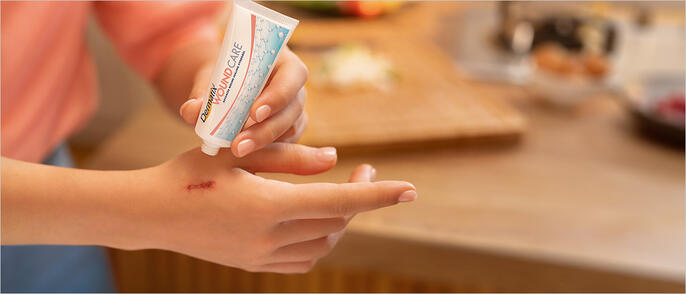Wounds vs Scars: Spot the Differences, Apply the Right Treatments
When it comes to treating wounds and scars, one of the most common reasons why treatments ‘don’t work’ is simply because the wrong treatments are applied. Today, let’s clear the air on wounds and scars, so you’ll know what to do – and what not to do – when healing your skin after a cut, scrape, burn or medical procedure.
Wounds 101: Wounds are physical injuries
So, what exactly is a wound? Simply put, a wound is a physical injury to the body that causes damage to the structure of the area that has been injured.

Scars 101: Scars are marks left after healing
Meanwhile, a scar is a mark that is left on the skin after a wound or injury has healed. Scars are a natural part of the healing process and can fade with the right treatment and over time, but may never completely disappear. (So beware any ‘cures’ that promise to eliminate scars 100%!)

Treating wounds and scars
With this in mind, it’s important that you administer the correct treatments for both wounds and scars (and don’t mix them up).
The three phases of wound healing
After an injury happens, a wound is formed. The healing process consists of three phases1,2,3 , namely:

Swelling (i.e nflammation)
At this stage, you will notice the wound getting red and swelling. Your body starts forming a clot to “plug” the wound and stop the bleeding. It also sends signals indicating that an injury occurred, so your body recognises the wound and begins the healing process.

Proliferation
This next stage is where the healing process takes place. New blood vessels are formed and damaged skin starts healing.

Maturation
This is the final phase of wound healing, and involves wound closure, the formation of scar tissue, and the contraction of the skin around the wound.
Your wound healing treatment should begin immediately after the wound occurs (i.e., as soon as possible after the injury) and last until the wound has healed, and you see the scar formed. This is essential as interruptions to the process may lead to delayed wound healing, or worse, a non-healing chronic wound.2,3
Treating your wound
These are the steps to take, so you can prevent infection, promote healing and minimise scarring:
Step 01
Clean the wound
Cleanse your wound with mild soap and water to remove any dirt or debris. Even if you can’t see any dirt, clean it anyway as bacteria may be present. Avoid using harsh antiseptics, as they could damage healthy tissue.

Step 02
Keep the wound moist:
Wounds heal best in an optimally moist environment, as hydration aids in healing. You can easily create this optimal moist environment by applying a topical treatment like Dermatix® Wound Care, which helps to create an optimally moist environment for wound healing.

Step 03
Protect the wound:
Apply a sterile dressing or bandage to keep it clean and prevent it from being contaminated.

In addition to keeping the wound moist, the intelligent hydrogel (Dermatix® Wound Care) also forms a barrier over the wound, accelerates healing, and helps to prevent infections4,5,6 (which is a crucial aspect of effective healing).
What’s more, Dermatix® Wound Care also offers an immediate, cooling sensation5 that relieves pain and alleviates itchiness – aiding the healing process.
Treating your scar
After the wound has fully healed and scab has fallen off, you can discontinue the use of your wound treatment. Now, it’s time to begin treating the scar.
While there are various ways to treat scars – including laser therapy, cryotherapy, dermal fillers, skin needling, surgery, and others5 – an effective and well-tolerated scar treatment is silicone gel. A popular choice is Dermatix® Ultra, which uses an innovative CPX Silicone technology and Vitamin C Ester formulation that has been clinically proven to lighten, soften and flatten scars7,8,9 when used over a 3-month period.10

Speaking with a medical professional
We hope this article has been helpful in getting you started in wound and scar care. Should you have any questions, please speak to your doctor for professional advice.



- Shi C et al. Front Bioeng Biotechnol 2020;8:182.doi: 10.3389/fbioe.2020.00182
- Guo S and DiPietro LA. J Dent Res 2010;89(3):219-29
- Gohmi ER et al. J Applied Polymer Sci 2019; DOI: 10.1002/APP.47738
- Zhang L, et al. Dermatol Ther (Heidelb). 2020 Oct;10(5):1075-1088
- Tan ST and Dosan R. Open Dermatol J 2019;13:34-40
- Korting HC, et al. J Eur Acad Dermatol Venereol 2011;25(2):130-7
- Chernoff WG, et al. Aesth Plast Surg 2007;31:495-500
- Yun IS, et al. Aesth Plast Surg (2013) 37:1176-1181
- Fulton JE. Silicone gel sheeting for the prevention and management of evolving hypertrophic and keloid scars. Dermatol Surg 1995;21:947-951
- Mercer NSG. Silicone gel in the treatment of keloid scars. Br J Plastic Surg. 1989;42:83-87



